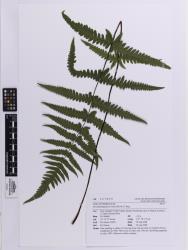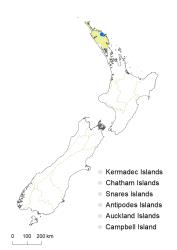- ≡ Gymnogramma aurita Hook., Icon. Pl. 10, t. 974 (1854)
- ≡ Phegopteris aurita (Hook.) J.Sm., Cult. Ferns 17 (1857)
- ≡ Polypodium auritum (Hook.) E.J.Lowe., Ferns 2, t. 51 (1858)
- ≡ Leptogramma aurita (Hook.) Bedd., Handb. Ferns Brit. India 377 (1883)
- ≡ Aspidium auritum (Hook.) Christ, Bull. Herb. Boissier sér. 2, 4: 616 (1904)
- ≡ Dryopteris aurita (Hook.) C.Chr., Index Filic. 253 (1905)
- ≡ Nephrodium auritum (Hook.) Hand.-Mazz., Symb. Sin. 6, 21 (1929)
- ≡ Thelypteris aurita (Hook.) Ching, Bull. Fan Mem. Inst. Biol. 6: 266 (1936)
In New Zealand Pseudophegopteris aurita is recognised by its long-creeping rhizome bearing ciliate scales, red-brown stipes and rachises, deeply 1-pinnate-pinnatifid laminae, the basal pair of pinnae shorter than those above, and the basal pair of pinnules on the proximal primary pinnae, especially the basiscopic ones, clearly longer than the adjacent pinnules. The rachis and costae bear short hairs, especially adaxially, but the laminae are otherwise glabrous. The veins are free, ending in hydathodes just before the margin. The sori are oblong and exindusiate, and the sporangia bear hairs on the stalk below the annulus.
North Island: Northland.
Altitudinal range: c. 10 m.
Pseudophegopteris aurita has been recorded spreading from a cultivated plant in a garden at Kerikeri. The cultivated plant was grown by a commercial fern nursery.
Occurs naturally in Bhutan, north-east India, Nepal, China, Japan, and south-east Asia as far as Papua New Guinea (Fraser-Jenkins et al. 2017).
Recorded as a cultivation escape, growing on a south-facing slope 40 m from the parent plant.
Ogle et al. (2021). AK 327895, 2008.
Pseudophegopteris aurita is distinguished from its congeners by its creeping rhizome with well-spaced fronds, red-brown stipes and rachises, deeply 1-pinnate-pinnatifid laminae, elongated basal basiscopic pinnules on the primary pinnae, stiff hairs on the lamina axes, and elongate sori.





